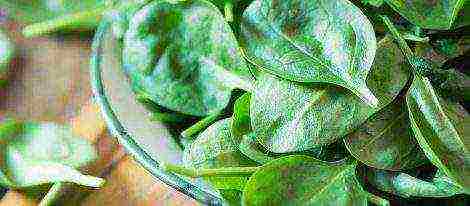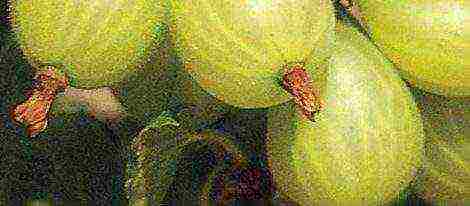Content
- 1 What varieties of plums are most suitable for giving
- 2 Early varieties of plums
- 3 Mid-season plum varieties
- 4 Late varieties of plums
- 5 The best varieties of plums
- 6 Plum varieties for the Moscow region and the middle zone
- 7 Early varieties of plums
- 8 Self-fertile varieties of plums
- 9 Large-fruited varieties of plums
- 10 Zarechnaya early
- 11 Kabardian early
- 12 Early Renclaude
- 13 Chachak early
- 14 Early
- 15 Red ball
- 16 Favorite Mlieva
When creating your summer cottage garden, you always want the work done to be in vain and eventually bear fruit. There are many fruit trees that are perfect for home growing, but it is worth remembering that each plant variety needs its own conditions, climate, soil, moisture, and more.

What varieties of plums are most suitable for giving
Plum is one of the most common garden trees, but it is worth remembering that this plant is extremely whimsical and requires constant care. Correctly selected seedlings will delight the gardener with their berries throughout the summer. Also, plums make excellent preparations for the winter in the form of compotes, preserves and marmalades. It is better to give preference to varieties of plums that are suitable for the terrain in terms of climatic indicators and soil characteristics on the site.
There are three main groups of plum trees, most of them take root well throughout Russia, but for some reason there is a very small variety of primitive varieties:
- Early ripening and early varieties - begin to bear fruit from the end of July to the first decade of August and are considered the most productive varieties of plums.
- Mid-season varieties - they begin to harvest from the second decade to the end of August and are considered the most delicious and fragrant varieties of plums, gardeners love to store jam and make tinctures from them.
- Late or very late varieties - begin to bear fruit from late August to mid-September, most varieties are frost-resistant, the fruits are used to harvest preservation for the winter.

The best varieties of plums for giving
Early varieties of plums
The most optimal option for amateur gardeners, as a rule, trees give a harvest 2-3 years after planting a seedling in the ground, the volume of the harvest increases every year.
- Cooperative - this variety has practically no drawbacks. Typically, the tree is of medium height and has a dense, deciduous crown. The tree blooms in white. The fruits have a rich, reddish-purple hue. The berries are juicy, weighing up to 40 g, very large, regular, oval. The pulp is greenish in color, dense, has a sweet taste with a slight sourness. The bone is easily separated from the pulp. The first harvest will please in three years at best.
- July plum - a very whimsical tree loves sunlight and does not tolerate high humidity. The crown is not too dense, average yield, up to 10 kg per tree. These are red plums with a pointed oval shape, medium or large in size 30–40 g. The sweet variety of plums has a juicy, yellow center. The seedling will delight with the first harvest already three years after planting.
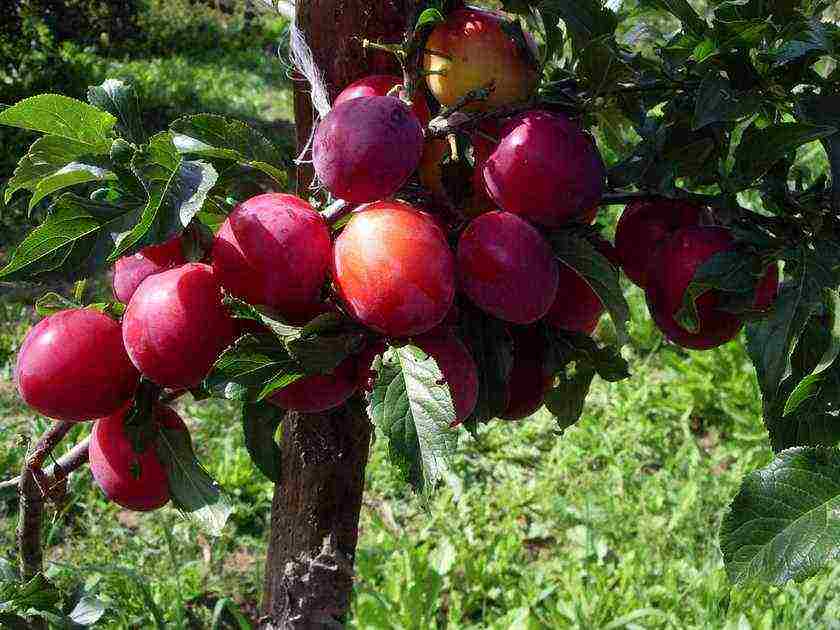
The best varieties of plums for giving
- Plum golden ball Is a variety of yellow plums that has an incredibly pleasant aroma and a peach aftertaste. The peculiarity of the variety is the high yield of grouped fruits, like sea buckthorn, but at the same time they reach very impressive sizes up to 55g.The seedling will delight with the first harvest already three years after planting in the ground.
- Plum Zarechnaya early - the tree reaches a medium height and has predominantly straight branches. The berries are blue-violet with a white silty bloom, rather large, the inner part is yellow in color with a sour taste. This is one of the most frost-resistant varieties of plums. Gardeners report high yields and disease resistance. Harvesting begins three, maybe four years after the seedling is planted in the ground.
- Plum Early - one of the most frost-resistant varieties of plums. Medium-sized tree with a fan-shaped crown. Red plums have a pleasant, sweet taste, juicy and aromatic. The tree can please with the first harvest already in the second year after planting.
- Red ball - a low-growing garden tree, 2 to 3 meters high. The berries have a rich reddish-amber hue, regular, round shape, large enough up to 45 g. This is a sweet variety of plum, yellowish-white pulp with a rich, pronounced aroma, with a memorable aftertaste. The tree is very fruitful, the first harvest should ripen in 3-4 years, after planting the seedling.
- Plum varieties Record - the tree is very fruitful and frost-resistant. It is rightfully called one of the best varieties of plums for a summer residence, in all respects. The berries are very large, dark blue or purple in color, have a significant waxy film. The pulp can be easily separated from the stone, is quite dense with a yellow tinge, has a very pronounced taste and a pleasant almond aroma.
The best varieties of plums for summer cottages. Photo
Mid-season plum varieties
These plums have a very rich taste and are most suitable for the preparation of fragrant jam or alcoholic tinctures, such trees are often found in home gardens and summer cottages.
- Mashenka - one of the best varieties of plums for summer cottages, has excellent taste. The tree grows medium-sized and cold-resistant, rarely sick and unpretentious to climatic conditions. The berries are dark purple in color, very large. The pulp is dense with a yellowish-greenish color, quite juicy and has a sweet, rich taste, the bone can be easily separated if desired.
- Memory of Babylon - the tree grows to medium size, unpretentious to the climate and grows in cold areas. Berries are bright red, amber, very large up to 90 g. The pulp has a pleasant aroma and pronounced taste with an almond aftertaste, quite juicy.
- Romain - a very productive tree, bears fruit almost every season, the leaves have a characteristic reddish tint. The berries are medium-sized, up to 20 g, red in color, have a rich taste, an amazing almond flavor. The pulp is juicy, deep red.
- Souvenir of the East - low-growing trees with a high yield up to 40 kg per tree. One of the main disadvantages of wood is the instability to cold. The berries are large, maroon or purple in color, have a characteristic sweetish-spicy taste. The flesh is firm and crispy.
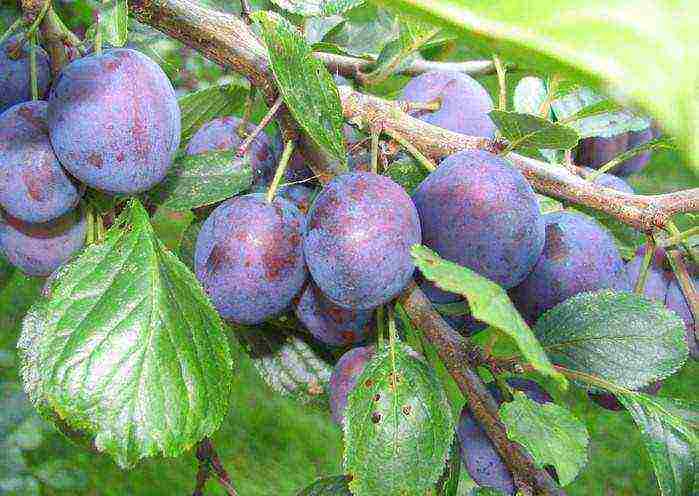
Late varieties of plums
Such plums are the most frost-resistant, but they are inferior in taste to mid-season varieties, while they have a high yield.
- Bogatyrskaya - the tree is unpretentious to climatic conditions, tolerates severe frosts and impresses with its fertility. An adult tree can produce up to 70 kg of berries from one tree. The berries are of a deep dark purple or blue hue, have an elongated oval shape, with a significant layer of waxy bloom. The pulp has a sweetish taste with a slight sourness near the stone itself, yellow in color. The tree is resistant to diseases and parasites.
- Zhiguli - the tree is not very whimsical, it grows in cold conditions and pleases with high fertility. The berries are deep blue or purple in color, reaching an average of 40-50 g. The flesh is greenish, dense and can be easily separated from the stone.
- Svetlana - the tree is not whimsical, resistant to cold weather, reaches an average height, very fruitful. A variety of yellow plum, has a pleasant sweet taste, rich aroma, juicy, firm pulp.
- Empress - a fairly tall tree, reaching an average of 4 m. Harvesting from one tree is 20-25 kg. The berries are dark blue or purple, not too large up to 45g. The pulp is yellow, juicy, aromatic, it is a sweet variety of plum. The first harvest occurs 4-5 years after planting.
- The president - one of the most versatile varieties of plums. The tree is fairly resistant to frost, the fruits of this plum variety are often used to make prunes. The berries have a rich, dark purple hue. The pulp is yellow light, has a pleasant aroma and rich taste, with a characteristic aftertaste of peaches.

The best varieties of plums
The best varieties of plums are determined by the main indicators:
- Frost resistance.
- Productivity.
- Disease resistance.
- Ripening time.
- The size of the fruit.
- Taste qualities.
- How easily the pulp separates from the bone.
- The whimsicality of the plant.
- Convenience of transportation.
From the examples of plum varieties given above, the most widely used ones can be distinguished.
- Early - Cooperative.
- Average - Mashenka.
- Later - Bogatyrskaya.
Often, amateur gardeners prefer high-yielding varieties of plums, but, as a rule, for home planting, it is better to give preference to less-yielding trees, since branches often break from the abundance of fruits, fruits and taste are unnecessarily crumbled, much worse. The average harvest is 40 kg per tree, which is quite a lot for winter harvesting.
- Plum varieties for the Moscow region and the middle zone
- Early varieties of plums
- Self-fertile plum varieties
- Yellow plum varieties
- The largest varieties of plums
Plum varieties for the Moscow region and the middle zone
When choosing a variety of plums for planting in areas of the Moscow region and the middle lane, preference should be given to varieties with high frost resistance and resistance to diseases and pests. It is also advisable to choose varieties of plums with an early ripening period, so that the harvest has time to ripen before the autumn frosts.
"Rapid"
"Fast-growing" is one of the most popular varieties of plum for the Moscow region and central Russia, early ripening and fruitful. Self-infertile species. For cross-pollination, a hybrid cherry plum, "Red Ball", is suitable.
- Productivity 30 kg per tree.
- Reddish cream with yellow sweet flesh weighing 30 g.
- The tree is undersized about 2.5 m with a fan-shaped thin crown.
- The time for fruit ripening is the first half of August.
- The first harvest can be obtained already in the third year after planting the seedling.
- It tolerates severe frosts down to -40, suitable for growing in the Moscow region and the middle lane.
- It is slightly damaged by diseases and pests.
Advantages of the view: tasty fruits, drought-resistant, excellent frost resistance, early maturity
Minuses: self-infertility, poor separation of the bone from the pulp.
"Yakhontovaya"
"Yakhontovaya" is an early ripe fruitful type of plum, partially self-fertile. To obtain bountiful harvests in the neighborhood, we need varieties for cross-pollination: "Skorospelka krasnaya", "Hungarian Moscow" or "Memory of Timiryazev".
- The harvest is 30 kg per tree.
- Yellow cream with a wax coating of 30-35 g with sweet and sour juicy pulp.
- The tree is of strong growth up to 5 m, the crown is neat spherical.
- Ripening of the crop by mid-August.
- Harvesting begins in the third or fourth year after planting.
- It tolerates frost perfectly, flower buds are resistant to spring frosts. The variety is zoned for the Moscow region and the middle zone.
- Satisfactory disease resistance.
Advantages of the view: early maturity, early ripening, frost resistance, easy separation of the bone from the pulp, fruits of excellent dessert taste.
Minuses: high tree height, partial self-fertility.
"Smolinka"
"Smolinka" is a precocious fruitful type of plum. Fruits of excellent taste are used fresh and for freezing, drying and preparation of prunes.
- Productivity 15-20 kg per tree.
- Dark purple cream weighing 35-40 g with sweet and sour tender pulp.
- Tall trees (5-5.5 m) with a thin crown.
- The harvest ripens in the second half of August.
- Plum begins to bear fruit in the fourth or fifth year of growth.
- Average winter hardiness, but sufficient for the conditions of the Moscow region and the middle zone. The branches quickly recover after freezing.
- With good care, resistance to major diseases is decent.
Advantages of the view: large fruits of high quality, good transportability.
Minuses: high growth of trees, self-fertile, branches without support can break under the weight of the fruit.
"Red ball"
"Red ball" with early ripening and excellent frost resistance. This variety is partially self-fertile; to obtain decent yields, pollinators are needed in the neighborhood, for example, "Skoroplodnaya" or hybrid cherry plum.
- Productivity 18 kg per tree. Red cream with a wax coating weighing up to 40 g. The pulp is yellow, juicy, sweet and sour in taste.
- The tree is not tall (about 2.5 m) with a rounded drooping crown.
- The fruits ripen by mid-August.
- Fruiting begins in the third year after planting.
- It perfectly tolerates severe frosts, but does not like thaws, after which it can freeze slightly. Recommended for planting in the Moscow region and the middle lane.
- It is practically not damaged by clasterosporium, but protection is needed from other diseases.
Advantages of the view: large tasty fruits, undersized trees, early maturity, high frost resistance, good transportability.
Minuses: during early flowering, damage by spring frosts is possible, partial self-fertility.
Early varieties of plums
The ripening time for early-ripening plum varieties is from late July to mid-August.
"Zarechnaya early"
"Zarechnaya early" - early ripening, fruitful. The variety needs cross-pollination. The best neighbors for this purpose are Volzhskaya krasavitsa and Etude.
- The annual harvest is 15 kg per tree.
- Dark purple cream weighing 40-50 g with yellow juicy pulp of sweet taste.
- The tree is medium-sized with a compact crown.
- The fruits are ready to be harvested at the end of July.
- Plum begins to bear fruit in the fourth year after planting.
- Winter hardiness is high. The variety is zoned for the Central Black Earth region.
- Disease resistance is good.
Advantages: early ripe, large sweet plums, the stone is easily separated from the pulp, excellent frost resistance, good transportability
Minuses: self-infertility
"Oryol Dream"
"Orlovskaya Dream" is an early ripe, frost-resistant plum variety with partial self-fertility. The best neighbors for cross-pollination "Skoroplodnaya" or cherry plum.
- Average yields are 10-12 kg per tree.
- Red cream with subcutaneous specks, weight up to 40 g. The pulp is yellow, juicy, sweet and sour.
- The tree is not tall, 2.5-3 m with a pyramidal crown.
- Ripening time is the first half of August.
- Begins to bear fruit in the third year after planting the seedling.
- Frost resistance is excellent. Recommended for growing in the Central Black Earth Region.
- High resistance to clasterosporium disease.
Advantages: early ripening, frost-resistant, early-growing, the cream does not crack.
Minuses: self-fertility is partial, the stone is poorly separated, the fruits become smaller with an abundance of harvest.
"Indira"
"Indira" is a variety of domestic plum of the last generation, early maturing, fruitful, winter-hardy.
- Productivity 20-25 kg per tree.
- Blue cream weighing 35-45 g with yellow sweet pulp.
- A tree of strong growth with a dense pyramidal crown.
- Ripening period is early.
- Bears fruit in the fourth or fifth year of growth.
- Average winter hardiness (up to -35). The variety is zoned for the Middle Volga region.
Advantages of the view: early ripe, large tasty fruits, good yield.
Minuses: average winter hardiness.
"Sissy"
"Nezhenka" is an early maturing variety, partially self-fertile. Plum "Skoroplodnaya", "Red ball" and cherry plum varieties are suitable as pollinating neighbors.
- Average yield up to 15 kg.
- Red cream weighing 25-30 g. The pulp is yellowish, juicy, sweet and sour.
- Temperate tree (2.5-3 m) with a sparse crown.
- The ripening time of the crop is mid-August.
- Bears fruit in the fourth or fifth year of growth.
- Has a high winter hardiness, zoned in the Central Black Earth region.
- Disease resistance is relative.
Advantages: early maturing, the fruits do not crack, the stone separates well from the pulp, excellent winter hardiness.
Minuses: fruits when ripe quickly crumble, partial self-fertility.
"Candy"
"Candy" is remarkable for its very early ripening period. This type of domestic plum is self-fertile and needs pollinating neighbors. The best were "Early Zarechnaya" and "Collective Farm Renklod".
- Productivity 25 kg per tree.
- Cream red-claret with a bluish bloom weighing 30-35 g. The pulp is yellow, jelly, very sweet taste.
- A tree of short stature (2.5-3 m) with a compact crown.
- The fruits are ready to be harvested at the end of July.
- Begins to bear fruit in the fourth year of growth.
- Average frost resistance (up to -20). When grown in the Central regions, it is better to cover the trunk for the winter.
- Resistance to major diseases is good.
Advantages: large sweet plums, short trees, fast-growing, fruitful, the stone is well separated from the pulp.
Minuses: self-infertile species needs pollinating neighbors, low keeping quality and transportability.
Self-fertile varieties of plums
Self-fertile varieties of plums are able to pollinate with their own pollen and bring good yields. They do not need pollinating neighbors, but if they are present, the yield increases significantly.
"Memory of Timiryazev"
"Pamyat Timiryazev" is notable for its high self-fertility, but with prolonged severe frosts (below -30), the fruit buds freeze and the yield may noticeably decrease.
- Productivity 10-15 kg, in favorable conditions up to 35 kg.
- Yellow cream with a reddish blush weighing 20-25 g with sweet and sour dense pulp, the stone is easily separated.
- Ripening of the crop in late August - early September.
- The tree is undersized (up to 3 m) with a drooping, rounded crown.
- The first harvest begins to bring in the 4th year after the planting of the soot.
- Average winter hardiness, but when freezing, the branches quickly recover. It is safely grown in areas of the middle lane.
- Resistance to major diseases is satisfactory.
Advantages of the view: early-fertile, self-fertile, disease-resistant, productive, good transportability.
Minuses: average winter hardiness, severely damaged by plum mites.
"Viola"
Viola is characterized by high self-fertility, excellent and stable yield.
- The yield is 25-30 kg per tree.
- Blue cream weighing 20 g with sweet and sour juicy pulp.
- Harvest is ready for harvest in early September.
- The tree is spreading, medium-sized.
- The first fruits bears in the third or fourth year after disembarkation.
- Frost resistance at an average level. Recommended for growing in the Middle Volga region.
- It is slightly damaged by diseases and pests.
Advantages of the view: high self-fertility, abundant yields, fast-growing, good transportability of fruits.
Minuses: small size of fruits, in dry summers plums can crumble, poor separation of the stone from the pulp.
"Morning"
"Morning" - has a high self-fertility, regularly brings good harvests. This variety is a good pollinator for many self-fertile forms of domestic plum.
- The harvest is 15 kg per tree.
- Yellowish-green cream with a pink barrel weighing 25 g with aromatic, tasty pulp. The bone is easily detached.
- Harvest is ready for harvest in early August.
- The tree is short with a crown of moderate density.
- The first fruits bears in the fourth or fifth year after planting the seedling.
- The frost resistance of the tree is average, and of the flower buds it is low. The variety is zoned for the Central region.
- Resistance to diseases and pests is satisfactory.
Advantages of the view: high self-fertility, early maturing, quickly recovering when freezing, good transportability.
Minuses: low frost resistance of flower buds.
"Peaceful"
"Mirnaya" is one of the self-fertile varieties of home plum.
- Productivity 25-40 kg per tree, annual yields, stable
- Burgundy-purple cream weighing 25-30 g with sweet and sour juicy pulp. The bone is separated well.
- The fruits reach ripeness in the first half of August.
- A tree of strong growth with an oval crown of moderate density.
- Begins fruiting in the fifth year after planting.
- Frost resistance is good enough. The variety is zoned for the Middle Volga and Lower Volga regions.
- Disease resistance is satisfactory.
Advantages: self-fertile, high-yielding, large tasty plums of universal use, good winter hardiness.
Minuses: ripening of fruits is non-simultaneous.
"Bogatyrskaya"
"Bogatyrskaya" is a self-fertile type of domestic plum, which gives very high yields from an early age.
- Yields are 50-60 kg, later up to 80 kg per tree
- Long, dark purple cream weighing 30-40 g with delicate sweet-sour pulp.
- The crop can be harvested in the second half of August.
- Begins fruiting in the fifth year after planting.
- Frost-resistant, zoned for the Lower Volga region.
- Disease and pest resistance is good enough.
Advantages of the view: self-fertile, high-yielding, large fruits with good transportability, high frost resistance.
Minuses: with abundant harvests, the branches may break and the fruits become smaller.
Yellow plum varieties
"Golden ball"
The "Golden Ball" is an early ripening type of yellow plum. The variety is self-fertile. The best pollinating neighbors "Skoroplodnaya" or hybrid cherry plum.
- The yield is 15 kg with a subsequent increase in the yield.
- Round cream, yellow with a pinkish blush, weighing 40-50 g. The pulp is fragrant, juicy, sweet with sourness near the stone.
- Ripening time is mid-August.
- Spreading tree with a height of 3-4 m.
- The first crop gives already in the third year after planting.
- Excellent winter hardiness. Zoned for the Central and Central Black Earth Region.
- Satisfactory resistance to major plum diseases.
Advantages of the view: large sweet fruits, early maturing, early-ripening, good transportability.
Minuses: self-fertility, with abundant yields, plums become smaller, low drought resistance.
"Golden large"
"Golden large" - a type of yellow domestic plum with a high yield, late ripening. Partially self-fertile. The best pollinating neighbors are Volzhskaya krasavitsa and Mirnaya.
- Yield 27 kg per tree
- Yellow cream with a ruddy barrel weighing 40 g with sweet and sour tender pulp. The bone is easily separated.
- Fruits ripen in the first half of September.
- Medium-sized tree with a sparse pyramidal crown.
- In the fourth year after planting, the seedling gives the first harvest.
- Frost resistance is satisfactory. The variety is zoned for planting in the Lower Volga region.
- Practically immune to disease.
Advantages: fruitful, tasty large plums, good transportability, high disease resistance, drought tolerant.
Minuses: late ripening of fruits, partial self-fertility.
"Covenant"
"Covenant" is a kind of yellow Chinese plum. Self-infertile variety. For pollination, pollinating neighbors are needed: hybrid cherry plum or other types of Chinese plum.
- Productivity is stable about 30 kg per tree
- Round yellow cream with a pinkish barrel weighing 25-30 g. The pulp is juicy, dense, sweet-sour in taste.
- The plum ripens in early September.
- Sprawling tree up to 3 m tall.
- Fruiting begins in the fourth year of growth.
- Frost resistance is high. Zoned across the Volga-Vyatka region.
- Disease resistance is excellent. Can be damaged by plum aphid and sawfly.
Advantages of the view: abundant productivity, good quality fruits, high winter hardiness.
Minuses: self-infertility, can be damaged by pests.
"Honey white"
"Honey White" is an early ripening variety of plum. Needs cross-pollination. The best pollinating neighbors are "Vengerka Donetskaya", "Renklod Karbysheva".
- The yield is 35-40 kg per tree.
- Oval cream, yellow with an orange barrel weighing 35-50 g with aromatic sweet pulp. The bone is not separated well.
- The harvest ripens at the end of July.
- The tree is vigorous in height up to 5 m with a thin crown.
- Begins fruiting in the fourth year of growth. Has a high frost resistance. It is safely grown in the Central Black Earth Region and the Moscow Region
- Practically unaffected by moniliosis. Medium resistance to other diseases
Advantages: sweet large fruits, early ripening, high frost resistance and drought resistance.
Minuses: strong tree growth, self-fertility.
Large-fruited varieties of plums
"Giant"
"Giant" is a large-fruited variety of plum with a high yield, self-fertile.
- Productivity 40 kg.
- Cream red-pink weighing 60-80 g with sweet and sour juicy pulp. The bone is not separated well.
- The harvest ripens at the end of August.
- A tree of medium height up to 4 m with a dense crown.
- The first harvest gives in the third or fourth year.
- Average winter hardiness (up to -34). Suitable for planting in the Lower Volga region.
- It is affected by moniliosis. Preventive measures are needed for protection.
Advantages: very large fruits, good yield, early maturity.
Minuses: average winter hardiness, low drought resistance
"Angelina"
"Angelina" - a variety of plums with very large fruits, self-fertile. Suitable for pollination "Traveler", "Black Amber", "Friar".
- The yields are plentiful and amount to 50-70 kg per tree.
- Deep purple cream weighing 90 g with sweet and sour juicy pulp.
- Fruits ripen in the second half of September.
- Spreading tree with a height of 3 m.
- The first fruits appear in the third year after planting.
- Average winter hardiness. Suitable for cultivation in the southern regions.
- Disease resistance is average.
Advantages: fruits can be stored in a refrigerator without freezing for 2-3 months, plums are large for universal use, early maturity, high yield.
Minuses: average winter hardiness and disease resistance
"The president"
“President” is a large-fruited type of plum, self-fertile and fruitful.
- Productivity 20-40 kg with subsequent building up to 70 kg from a tree
- Oval cream, burgundy-purple, weighing 60-70 g, sweet taste.
- Plums ripen in the second half of September.
- The tree is spreading, thickened with a height of 3-3.5 m.
- Begins fruiting in the fifth year.
- Average winter hardiness (up to -30). The variety is adapted for the forest-steppe and steppe zones
- Average resistance to major diseases
Advantages of the view: large sweet fruits, high yield, self-fertility, drought resistance
Minuses: dense and spreading crown requires formation and thinning, is damaged by plum aphid and moth, prone to gum flow
"Start"
"Starter" is a large-fruited variety, very early ripening, self-fertile. The pollinator can be a variety of home plum, which coincides in terms of flowering.
- Low yield 60 kg / ha.
- Round, burgundy-violet cream weighing 50-70 g. The pulp is juicy, sweet with sourness. The bone is easily separated from the pulp.
- The fruits ripen at the end of July.
- A medium-sized tree with a dense crown.
- Fruiting begins in the third or fourth year after planting the seedling.
- Good winter hardiness.Zoned for the Central Black Earth Region.
- High resistance to diseases and pests.
Advantages: large tasty fruits, good transportability, early ripening.
Minuses: self-fertile, low yield.
Save article to:
Dear visitors of the "Dacha Plot", tireless gardeners, gardeners and flower growers. We offer you to pass the aptitude test and find out if you can trust the shovel and let you into the garden with it.
Test - "What kind of summer resident I am"
Share this article with your friends:
Gardeners consider the plum to be almost the most whimsical fruit tree. But the taste of juicy sweet fruits is worth the work and trouble that a farmer does when caring for his garden. Today there are many varieties of plums that are suitable for different regions, therefore, when choosing seedlings for planting, you need to pay attention to their characteristics. In a huge assortment, every gardener will be able to find a variety that suits him.
Alyonushka

Plum variety with early ripeness. The height of the tree usually does not exceed 3 meters. The fruits are rounded, they reach 40 mm in diameter, weigh 30-40 grams, the skin tone is deep red. The pulp is medium-dense, juicy, orange color, sweet and sour taste. When ripening, the fruits do not crack, the variety is frost-resistant and practically immune to most ailments that plums get sick with.
Back to contents ↑ Anna Shpet
Late-ripening fruitful variety, bred by the German breeder L. Shpet. The plant is tall and durable. The fruits are oval, less often ovoid, even on the sides, weighing up to 50 grams each, the color of the dense skin is violet-red, there is a waxy bloom, the pulp density is good, the color is yellow-green. The variety tolerates wintering and dry weather relatively well, but is often affected by various ailments.
Back to contents ↑ Bogatyrskaya
A mid-ripening variety of self-fertile plum. The tree grows short. Fruits are formed of medium size, their average weight is 40 grams, the skin color is deep purple, with the presence of a waxy coating, the shape is slightly elongated oval. The pulp tastes sweet and sour, its color is yellow-green. The variety is resistant to cold weather, the fruits tolerate transportation well, the plants are poorly exposed to diseases.
back to contents ↑ Hungarian
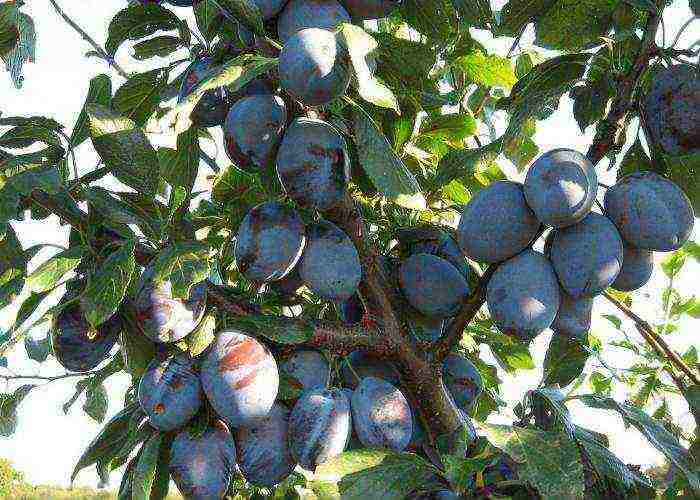
A variety with a late period of reaching full fruit ripeness. The tree is medium-sized, the variety is large-fruited, the weight of its fruits is 100 grams, the skin has a blue-violet color, a waxy bloom is present. The pulp is juicy, sweet in taste, the density is average. The variety is valued for its regular yield and immunity to the main ailments affecting the plum, this variety is one of the best for the Moscow region.
back to contents ↑ Volga beauty
The fruits reach a weight of about 40 grams, the shape is round, slightly elongated, the density of the pulp is medium, dark yellow in color, the taste is sweetish-sour, the fruits are covered with a purple skin. This variety is universal, it survives the wintering painlessly, the fruits retain their qualities during long-term transportation.
back to contents ↑ Eurasia
Early ripening variety of table plum. The height of an adult plant usually does not exceed 5 meters, the plant is medium spreading. The shape of the fruit is round, the color of the thin skin is dark blue with a bloom. The weight of the fruit varies between 20-30 grams, the color of the flesh is orange-yellow, its structure is loose and juicy. The variety is a representative of the group of self-fruitless plums, the resistance to cold is quite high.
back to contents ↑ Zarechnaya early

Early ripening high-yielding variety. The plant is medium-sized, the crown is compact. When formed, the fruits look like a slightly rounded oval, the maximum weight of one is 50 grams, the integumentary color is deep purple with a thick bloom. The structure of the pulp is dense, the color is amber, the taste is sour-sweet.The variety stands out among the comrades-in-arms for its frost resistance, the annual yield is stable, the commercial qualities of the fruits are high.
back to contents ↑ Candy
The ultra-early variety got its name from the sweetness of the fruit. The height of the fruit tree does not exceed 3 meters, the plant looks compact. The fruits are round, weighing about 30-40 grams, the color of the thin skin is claret-red with the presence of a bluish bloom. The pulp is sweet in taste, its color is honey-yellow. The variety is well adapted to cold weather, painlessly tolerates frosts down to -20 degrees, and is immune to most common diseases.
back to contents ↑ Red ball
The plum variety with an early ripening period is very popular in many regions, including the Leningrad region. The fruit tree grows to a height of about 2.7 meters, the crown is of medium density, the plant is spreading. The fruits are round in shape and large in size, the weight of one is about 45 grams, covered with a smooth red skin with a bloom. The variety tolerates cold well, the fruits can be transported over long distances.
back to contents ↑ Ksenia

An early ripe large-fruited variety for universal use. The plant does not grow tall. The fruits are shaped like an oval, the weight is 35-40 grams, the skin color is yellow, but there is a red blush, the pulp is sweet in taste, juicy, its color is yellow-green. The variety belongs to the group of self-fertile plum species, it tolerates wintering quite well, the yield is irregular.
back to contents ↑ Honey
From the name it is clear that the taste of the fruits of this early ripening variety of plums, bred in Ukraine, is very sweet. The fruit tree grows up to 5 meters in height, the foliage density is average. The fruits are rounded and rather large, their weight is not less than 40-60 grams, they are covered with a bright yellow skin, the flesh has a similar color, the structure is dense. The fruit is well transported, the variety painlessly survives frosts and dry weather.
back to contents ↑ Tender
A productive early ripening variety. The height of the tree generally does not exceed 2.6 meters, the crown is not dense, spherical. The fruits are round in shape, about 40 mm in diameter, weigh an average of 25-35 grams each, the skin is red in color, and the flesh is yellow, the structure is medium density. The variety is frost-resistant, its immunity to clasterosporium is average.
back to contents ↑ Nika
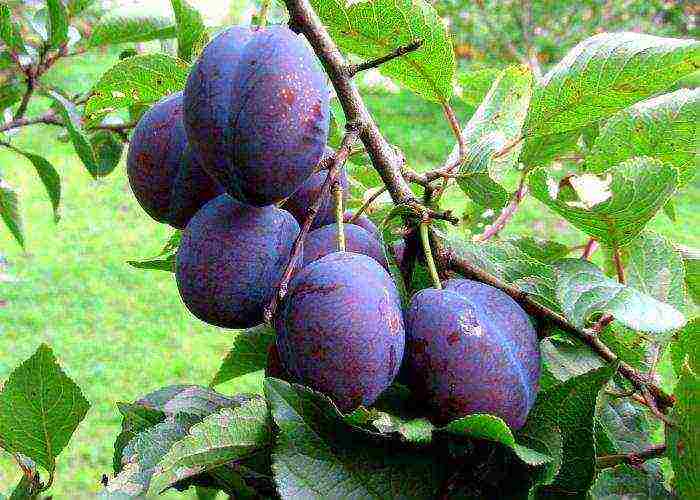
Representative of early ripening plum varieties. The height of the tree is usually average, but there are also strong-growing specimens, the plant is spreading, the crown is not too dense. The fruits have an oval slightly elongated shape, the average weight is 40-50 grams, reaching biological ripeness, the fruit skin becomes a dark purple hue, plaque is present. The structure of the pulp is dense, juicy, sweet on the palate. The variety is immune to common plum ailments.
back to content ↑ Peach
The variety belongs to early maturing and large-fruited, the plant is medium-sized, the crown is not too dense. Fruits are generally rounded, less often ovoid, slightly flattened at the tops, on average weighing 40-50 grams, but sometimes they can reach 70 grams. The skin is dense, has a yellow-green color with a purple blush, the structure of the pulp is dense, juicy, its taste is sweet and sour, the winter hardiness of the variety is quite low, but it is resistant to disease.
back to contents ↑ Renclaude
A variety of home-grown early-ripening plums. The plant is medium-sized, can grow up to 3 meters in height, spreading. The fruits have a round shape, usual for plums, their sizes are rather small (20-25 grams), reaching biological ripeness, they are covered with a yellow-green skin. The pulp of the fruit is juicy, medium-dense. The variety is appreciated by gardeners for its high level of cold resistance.
Back to contents ↑ Blue Gift
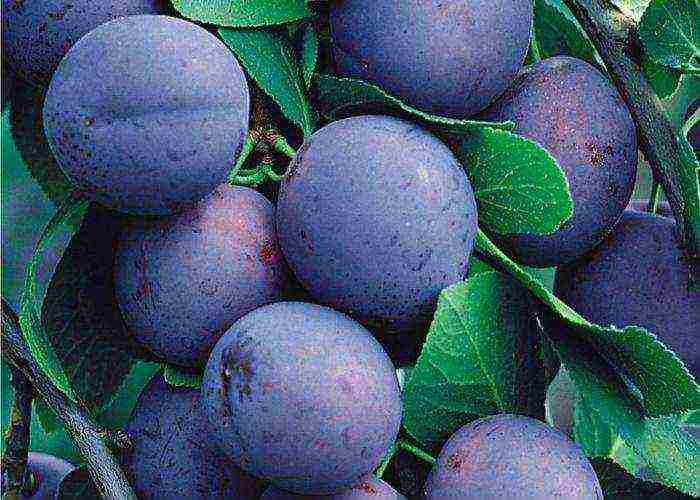
The variety has early maturity dates. The tree does not grow very tall, the crown is not thickened.The oval shape of the fruits and their small size (10-15 grams) distinguish this variety from others, the skin tone is dark purple, and a waxy coating is present. The pulp is green with a yellow tinge, the structure is dense and juicy. The cultivar is self-fertile and does not require pollinator plants.
back to contents ↑ Stanley
A medium late ripening variety developed by US breeders. The tree is not tall, the crown density is weak. The fruits are ovoid, not even from the sides, large, weighing up to 60 grams, the integumentary color is deep purple, plaque is present. The color of the pulp is yellow, it is fibrous and dense. This variety of plum is quite winter-hardy, but it is not very popular in the regions of Siberia and the Urals.
back to contents ↑ Morning
An early ripe variety of home plum, suitable for cultivation in the Middle lane. The plant is not tall, the crown density is medium. The shape of the fruit is oval, and the mass is about 25-30 grams, the color of the skin is green with yellowness, there is a slight bloom, the pulp has a dense structure, juicy. The fruits tolerate transportation well, the frost resistance of the variety is average, and the resistance to ailments is high.
back to contents ↑ Prunes
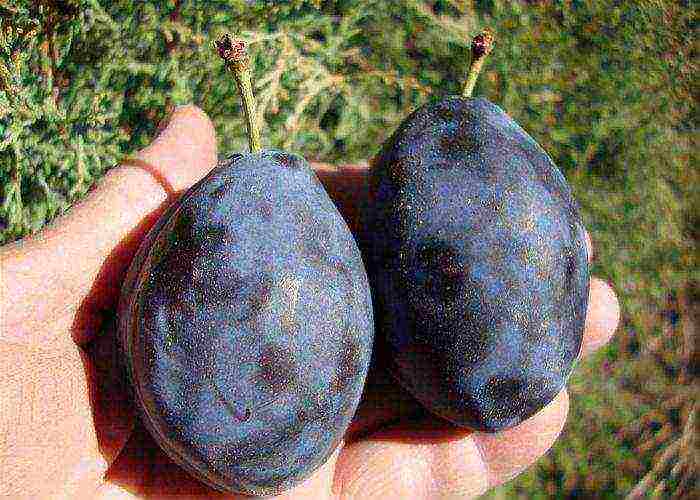
The ripening dates of the fruits of this variety of home plum are medium late. The fruit tree grows quite tall, the crown is not too dense. The shape of the fruit is often rounded, less often rounded-elongated, the mass varies from 40 to 60 grams, the shade of the dense skin is blue-violet, the flesh is yellow, the taste is sweet. The variety is self-fertile, high-yielding and winter-hardy.
back to contents ↑ Study
A variety with early periods of full ripeness of the fruit. Plant height above average, average crown density. The fruits are oval-ovoid, covered with a violet-reddish skin, thick waxy coating. The pulp is juicy, the structure is dense, the taste is sweet with a slight sourness. The variety is appreciated for its high level of winter hardiness and immunity to the main ailments that affect the plum.
Want to plant a plum but don't know which variety to choose? Take a closer look at these early and mid-early varieties. The sweet and aromatic fruits are sure to please.
Since these plums are famous primarily for their delicious pulp, the fruits are ideal for fresh consumption. Juice, syrup, jam and compote are also good, but in the processed form, the taste and aroma of plums will be less bright.
Zarechnaya early
This is the most popular early ripening variety of domestic plum. The compact tree has an oval or rounded crown. Branches are dark brown, slightly curved. Leaves are oval, dark green.
At the end of July, large fruits (weighing 35-50 g) of an oval or round shape ripen evenly on the tree. The skin is of medium density, dark purple, with an intense waxy bloom. The abdominal suture is clearly visible on the fruits. The pulp is dense, amber, well separated from both the skin and the stone. It is very tender, juicy and pleasant to the taste, almost no sourness is felt.
This early plum bears fruit for 3-4 years, is not afraid of frost, in the spring the flower buds do not freeze. The plant is self-fertile, the best pollinating varieties are Volzhskaya krasavitsa, Renklod Tambovskiy, Etude.
Kabardian early
The tree grows up to 6 m high, bears fruit for 4-5 years after planting. The crown is pyramidal and thick. The plant blooms in early May and begins to bear fruit in July. It does not need pollinating varieties for fruit setting. Plums are rather large (weighing 40-45 g), rounded, with a purple-violet hard skin and yellow sweet pulp, which exudes a rich aroma. The fruits are well transported, but not stored for long.
On the tree sometimes double fruits ripen, the mass of which reaches 70 g.
The main disadvantage of this plum is that the plant does not tolerate cold winters. It is recommended to grow it in the southern regions.
Early renclaude
This early variety of plum was bred in Ukraine, but it is successfully cultivated in cooler regions, since the plant has good winter hardiness.
A plum tree can reach a height of 5 m. At the end of July, large fruits (weighing 40-50 g) of a round shape ripen on it. The skin is dense, yellow, covered with a waxy coating. Sometimes a golden orange blush appears on it. The pulp is greenish-yellow, juicy and sweet, with a honey flavor and aroma.
Early rennlode has long fallen in love with many gardeners due to its very tasty fruits and high yield. However, this variety is self-fertile, therefore it is necessary to plant plums of one of the varieties nearby: Renklod Karbysheva, Vengerka Donetskaya, Vengerka Donetskaya early.
Chachak early
This variety has many synonyms: Chachak is the best, Chachak is the best, Chachak is the best, etc. The tree has a rounded oval crown and reaches a height of 3 m. It blooms in early May, and in the second half of July (3 years after planting) gives large fruits (about 50-60 g) are ovoid. Their skin is pink-purple with a blue waxy coating. The pulp of the fruit is dense, green-yellow, juicy, very sweet and aromatic. During transportation, the fruits are not damaged, and in the refrigerator they can be perfectly stored for 2-3 weeks without losing taste and presentation.
This plum is relatively frost-resistant, but in lowlands on moist soils in winter, young shoots can freeze slightly. In addition, the buds and flowers are afraid of recurrent frosts. The variety is self-fertile, so pollinating varieties are indispensable. Stanley, Nenka, Voloshka, Chachakskaya lepotika, Empress, German, Valor, President will do.
Early
This early variety of Chinese plum is distinguished by good frost resistance (up to -40 ° C), the tree is not afraid of recurrent frosts and is able to safely tolerate drought. The crown is spreading, rounded or fan-shaped. Leaves are light green, medium-sized.
In late July - early August, small fruits ripen on the tree (weighing 20-27 g). They have a dense yellow-red skin with a thin layer of waxy coating. Plums of various colors can ripen on the tree at the same time: from yellow and orange to all shades of red.
The pulp is yellow, juicy, aromatic, sour-sweet, often it does not separate well from the stone. Productivity is high (about 10 kg per tree), but every 2-3 years there is a bad harvest.
The variety is self-fertile. The best pollinators are the Red Ball, as well as any varieties of Russian plum and hybrid cherry plum.
Red ball
The tree grows up to 2.5 m high, bears fruit for 2-3 years after planting. Hanging branches form a spreading crown with a rounded shape and medium density. Leaves are green, matte. Fruits are formed on annual shoots and bouquet branches at the end of August. Plums are rather large (weighing about 40 g), round. Their dense red skin is covered with a waxy bloom of a bluish tint. The pulp is light yellow, very juicy, sweet (with a barely perceptible sourness) and aromatic.
This tree is quite winter-hardy: it can withstand frosts down to -35 ° С. However, spring return frosts can kill the buds. In addition, the plant can support.
Plum Red ball - self-fertile. Chinese plum (any varieties), Russian plum, hybrid cherry plum are best suited for the role of pollinators. But homemade plum is not good.
Favorite Mlieva
This early plum has a compact, rounded crown. The fruits ripen on the tree in late July - early August. They are very large (weighing up to 80 g), oval in shape, with a deep abdominal seam. The skin is light green. The pulp is fibrous, juicy, aromatic, sweet, easily separated from the stone.
Ripe fruits hang on the tree for a long time and do not crumble. The plant is resistant to diseases, but can be attacked by pests, in particular the moth.
The variety is self-fertile, the best pollinators are Renklod Altana, Renklod Ulensa, Chachakskaya early.
What early varieties of plums do you prefer?
